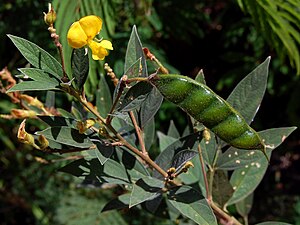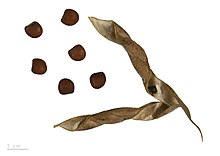Pigeon pea
| Pigeon pea | ||||||||||||
|---|---|---|---|---|---|---|---|---|---|---|---|---|

Pigeon pea ( Cajanus cajan ) in West Timor |
||||||||||||
| Systematics | ||||||||||||
|
||||||||||||
| Scientific name | ||||||||||||
| Cajanus cajan | ||||||||||||
| ( L. ) Millsp. |
The pigeon pea ( Cajanus cajan ) is a flowering plant in the subfamily Schmetterlingsblütler (Faboideae) within the family of the Leguminosae (Fabaceae). This useful plant is cultivated in large parts of the tropics and subtropics .
description
Appearance and leaf
The pigeon pea is erect shrub or shrub , the stature heights of usually 1.5 m to 3, more rarely 4 m are reached. The bark of the branches is noticeably ribbed and haired with golden, adjoining or slightly protruding, silky trichomes .
The leaves are pinnate in three parts. The partial leaves are 2.5 to 10 cm long, 1.4 to 3.5 cm wide, elliptical to lanceolate, pointed wedge-shaped, the upper side is green in color, the underside is paler and silvery gray-green. The hair on the top consists of fine, short and velvety hairs, the underside is clearly longer covered with whitish hair. There are small yellowish glands on both sides of the leaf. The leaf veins emerge on the underside and are yellowish in color. The petiole is 1 to 5.5 cm long, the leaf axis 0.8 to 1.3 cm, the petioles of the partial leaves 2 to 4 mm. The petiole, leaf axis (leaf rhachis ) and partial petioles are hairy yellow-brown.
Inflorescence and flower
The terminal panicle inflorescence is accompanied by a multitude of axillary racemose inflorescences near the branch tip . The inflorescence stalk is 2 to 7 cm long. The early falling bracts are pointed ovoid and 8 mm long and 5 mm wide. The flower stalks are 1 to 1.7 cm long. All parts of the inflorescence are hairy yellow-brown.
The hermaphrodite flower is zygomorphic and five-fold with a double flower envelope . The calyx consists of a 5 mm long calyx tube followed by 4 to 7 mm long calyx teeth, the calyx is yellow-brown and hairy with glands. The flower crowns have the typical structure of the butterfly flowers. The basic color of the petals is yellow with red-brown to dark red stripes, the outside is also covered in a similar color. The crown is almost round with a diameter of 1.2 to 1.7 cm. The wings are yellow and the shuttle is colored yellow-green.
Fruit and seed
The legumes are straw-colored, but often coated in purple-black, hairy and glandular. They are almost straight, 4.5 to 10 cm long and 0.8 to 1.4 (rarely only 0.5) cm in diameter. The seeds are yellow-brown, cream-colored, brown or reddish with a chestnut-brown hilum , they are weak and finely grained, 6 to 6.5 mm long and 4.5 to 5.5 mm wide.
Occurrence
The pigeon pea is cultivated in large parts of the tropics and subtropics and is found at altitudes between sea level and 1,450 meters, but probably also grows at higher altitudes. It grows wild in rubbish dumps, open, coastal forest areas and other locations.
use
India
In India, peeled and halved pigeon pea seeds are known as Tuvar Dal as the most widespread legume and the main source of protein in a vegetarian diet. Tuvar Dal is used in numerous Indian dishes, such as in the South Indian Sambar or in the North Indian Tadka Dal .
swell
- B. Mackinder, R. Pasquet, R. Polhill, and B. Verdcourt: Cajanus cajan . In: Flora Zambesiaca , Volume 3, Part 5, 2001.
- SI Ali: Description in the Flora of Pakistan. (engl.)
Individual evidence
- ^ "Toor dal prices go through the roof" In: " The Hindu ", August 21, 2015.
- ^ "Tadka Dal" From: northindiancooking.com, accessed on May 22, 2016.



